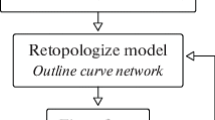Abstract.
Geometrical models output from CAD software often require modification before they may be used for analysis-quality mesh generation. This is due primarily to the inconsistencies in tolerances used by the CAD operator and the tolerances required for analysis. This paper presents a method for construction of watertight surface meshes directly on imperfect non-modified CAD models. The method is based on a hierarchical grid topology structure that defines a surface mesh by a grid and a collection of curves defining the boundary. Curve boundaries on component surfaces are iteratively split and merged according to user-set tolerances, allowing adjacent surface meshes to become computationally watertight via their shared edge curves. The collection of watertight surface meshes may then be made model-inde-pendent through interactive agglomeration of the surface meshes, followed by refinement and decimation sweeps to remove artifacts of original surface edges. Interactive procedures used for difficult cases are also explained, as are ongoing efforts for further automation.
Similar content being viewed by others
Author information
Authors and Affiliations
Rights and permissions
About this article
Cite this article
Steinbrenner, J., Wyman, N. & Chawner, J. Procedural CAD Model Edge Tolerance Negotiation for Surface Meshing. EWC 17, 315–325 (2001). https://doi.org/10.1007/PL00013392
Issue Date:
DOI: https://doi.org/10.1007/PL00013392




